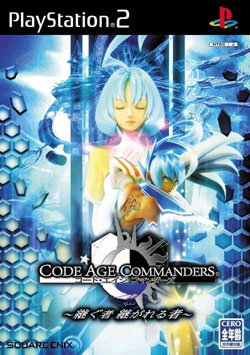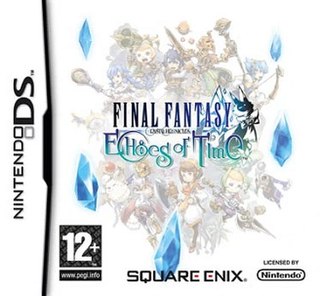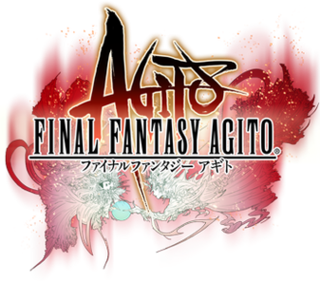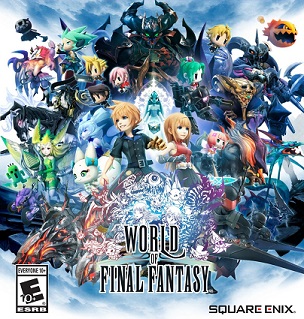
Final Fantasy IV, titled Final Fantasy II in its initial North American release, is a 1991 role-playing video game developed and published by Square for the Super Nintendo Entertainment System. The fourth main installment of the Final Fantasy series, the game's story follows Cecil, a dark knight, as he tries to prevent the sorcerer Golbez from seizing powerful crystals and destroying the world. He is joined on this quest by a frequently changing group of allies. Final Fantasy IV introduced innovations that became staples of the Final Fantasy series and role-playing games in general. Its "Active Time Battle" system was used in five subsequent Final Fantasy games, and unlike prior games in the series, IV gave each character their own unchangeable character class — although at a few points in the story, a dark knight will choose the path of a paladin, or a summoner will evolve to a new tier of spellcasting.

Final Fantasy Crystal Chronicles is an action role-playing video game developed by The Game Designers Studio and published by Nintendo for the GameCube. It was released in 2003 in Japan and 2004 in North America, Europe and Australia. A remastered version for Nintendo Switch, PlayStation 4, Android, and iOS was released in August 2020. A spin-off of the Final Fantasy series and beginning of the series of the same name, Crystal Chronicles was the first title in the franchise to be released for a Nintendo home console since Final Fantasy VI in 1994.

Kumi Tanioka is a Japanese composer and pianist. Born in Hiroshima, Japan, she graduated from Kobe University with a degree in musical performance, and began working as a video game composer in 1998. She joined video game developer and publisher Square that same year, and worked on over 15 games for them before leaving to work as an independent composer in 2010.

Akitoshi Kawazu is a Japanese game designer, director, producer and writer. After joining Square in 1985, he went on to become a central developer for the first two Final Fantasy titles, then acted as creator and lead developer for the SaGa series.

Fantasy Earth Zero was a 2006 massively multiplayer online role-playing game developed for Microsoft Windows. Originally developed by Puraguru and Multiterm under the title Fantasy Earth: The Ring of Dominion, it was released by Square Enix as a paid product through its PlayOnline service. It relaunched under Gamepot as a free game, and was later handled by developers SoftGear and Ocean Frontier and was transferred back to Square Enix. Under the premise of a world where rival kingdoms engage in frequent conflicts, players choose an allied kingdom and fight against each other in groups of up to fifty players. The game closed down in September 2022.

Final Fantasy Crystal Chronicles: The Crystal Bearers is an action-adventure game developed by Square Enix and released for Wii. It was released on November 12, 2009 in Japan and on December 26 in North America. The game received a mixed reception.

Final Fantasy Type-0 is an action role-playing game developed and published by Square Enix for the PlayStation Portable (PSP). Released in Japan on October 27, 2011, Type-0 is part of the Fabula Nova Crystallis subseries, a set of games sharing a common mythos which includes Final Fantasy XIII and XV. The gameplay, similar to Crisis Core: Final Fantasy VII, has the player taking control of characters in real-time combat during missions across Orience. The player also engages in large-scale strategy-based battles on the world map, and has access to a multiplayer option during story missions and side quests.

Code Age Commanders: Tsugu Mono Tsugareru Mono is a Japan-exclusive action role-playing game developed and published by Square Enix on October 13, 2005, for the PlayStation 2. It is part of the Code Age series, a franchise created by video game artist Yusuke Naora and designed to span different interweaved titles in multiple platforms and media. The series consists of Commanders, the mobile phone game Code Age Brawls, and the manga Code Age Archives. The story depicts the struggles of people surviving in a fictional "intraglobular world" menaced by impending destruction, mysterious warped creatures, and different factions warring against each other. The game focuses successively on the viewpoints of four main protagonists.

Final Fantasy Tactics A2: Grimoire of the Rift is a tactical role-playing game developed and published by Square Enix for the Nintendo DS handheld game console. Releasing in 2007 in Japan and 2008 in the West, the game is a sequel to Final Fantasy Tactics Advance and forms part of the Ivalice Alliance, a group of games set in the titular fictional universe. The game features cameo appearances from central and supporting characters from Final Fantasy XII, a title set in Ivalice.

Final Fantasy Crystal Chronicles: My Life as a King is a video game developed for the WiiWare service of the Wii console by Square Enix. Square Enix decided to make a game for the WiiWare service that would be high profile, and it was decided that the game would be a simulation game and, later in development, a Final Fantasy title.

Final Fantasy IV: The After Years is an episodic role-playing video game co-developed by Matrix Software and Square Enix, as the sequel to the 1991 title Final Fantasy IV. Set 17 years after Final Fantasy IV, The After Years follows the original cast and their descendants in episodic tales as a new villain appears, setting into action a mysterious chain of events that threatens the fate of the Blue Planet. Largely utilizing assets, locations, and mechanics from its predecessor, the title incorporates higher quality character graphics and several new gameplay systems.

Crystal Defenders is a set of two tower defense video games developed and published by Square Enix. The games use the setting of Ivalice and design elements from Final Fantasy Tactics A2: Grimoire of the Rift, forming part of the wider Final Fantasy franchise. The games feature a selection of characters sporting Final Fantasy-based character classes, and play out tower defense scenarios against recurring series of monsters. The first game in the series is Crystal Guardians, which was released in three parts for Japanese mobile phones in 2008. It was adapted for iOS later that year as Square Enix's first game for the platform, and renamed Crystal Defenders. Under that name, the game was also released between 2009 and 2011 for Android, Xbox Live Arcade, WiiWare, and PlayStation 3 and PlayStation Portable via the PlayStation Store. It was re-released with graphical improvements for iOS as Crystal Defenders Plus in 2013. A sequel, Crystal Defenders: Vanguard Storm, was released for iOS in 2009.

Final Fantasy Crystal Chronicles: Echoes of Time is a Wii and Nintendo DS action role-playing game in the Final Fantasy Crystal Chronicles series developed by Square Enix.

Final Fantasy Crystal Chronicles: My Life as a Darklord is a 2009 tower defense video game developed and published by Square Enix for the Wii and distributed through the WiiWare download service. The game is an entry in the Final Fantasy franchise, forming part of the Crystal Chronicles subseries. Taking place after Final Fantasy Crystal Chronicles: My Life as a King, the game follows the titular Darklord as she defends her mobile tower from waves of attacks as it travels across the kingdom.

Final Fantasy Dimensions is a role-playing video game developed by Matrix Software and published by Square Enix for mobile devices. Similar to Final Fantasy IV: The After Years, it was initially released as an episodic game, with the first two installments released in September 2010 on the Japanese i-mode distribution service, and in December 2010 for the EZweb distribution service. The game was remade for the iOS and Android platforms and released internationally in August 2012.

Final Fantasy Agito was a role-playing video game developed and published by Square Enix for mobile devices. The game's story was set in the universe of Final Fantasy Type-0, and was an entry in the Fabula Nova Crystallis subseries. A downloadable episodic game similar to Final Fantasy Dimensions, it featured a turn-based combat system encouraging both single-player exploration and multiplayer combat. There was a day-night cycle tied to the real-world time of day, and it featured a social element whereby talking with and befriending certain characters advanced the player's ranking in the game.

World of Final Fantasy is a role-playing video game developed by Tose and published by Square Enix. It is a spin-off of the Final Fantasy franchise, featuring characters from across its mainline and supplementary entries. Initially released for PlayStation 4 and PlayStation Vita in 2016, it was later ported to Windows in 2017. An updated version, World of Final Fantasy Maxima, was released as a port for Nintendo Switch and Xbox One in 2018, with the PS4 and Windows versions receiving the Maxima update as downloadable content.
Final Fantasy Crystal Chronicles is a series of video games within the Final Fantasy franchise developed by Square Enix. Beginning in 2003 with the game for the GameCube, the series has predominantly been released on Nintendo gaming hardware and covers multiple genres, including action role-playing. The Crystal Chronicles series takes place in an unnamed world inhabited by four tribes. Recurring themes include creating objects from memory and the importance of family. The gameplay, which has always been aimed at as wide an audience as possible within a genre, generally involves either multiple players or a large group working together.

Final Fantasy III is a Nintendo DS role-playing video game and a remake of the 1990 Family Computer game, Final Fantasy III.



















